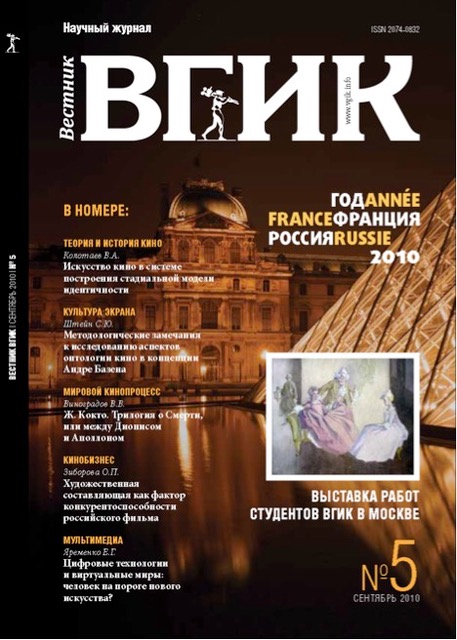Film Art in the System of Forming a Stage Identity Model
- 作者: Kolotayev V.A.1
-
隶属关系:
- VGIK,Russian Liberal Arts University
- 期: 卷 2, 编号 3 (2010)
- 页面: 6-29
- 栏目: THEORY AND HISTORY OF CINEMA | AUDIOVISUAL ARTS
- URL: https://journals.eco-vector.com/2074-0832/article/view/15105
- DOI: https://doi.org/10.17816/VGIK236-29
- ID: 15105
如何引用文章
全文:
详细
The article examines the processes of forming stage identity models in the artistic space of cinema that possesses a modeling function, the ability to create new identity types, to influence the formation of a personality and change social relations. A screen art work both reflects the inner identity changes and offers the culture subjects some plausible behavior models for self-identifying in everyday life. By analyzing a number of ilms the author singles out four stages of identity development and deines their main characteristics. The structure and process of identity formation are treated as the result of interaction with culture. The configuration of identity depends on the prevalent cultural system. The notions "Culture 1" and "Culture 2" are revised and such concepts as "product culture" and "conlict culture" are introduced.
作者简介
Vladimir Kolotayev
VGIK,Russian Liberal Arts University
编辑信件的主要联系方式.
Email: vestnik-vgik@vgik.info
доктор филологических наук; РГГУ,ВГИК; VGIK,Russian Liberal Arts University
参考
- Бергер П., Лукман Т. Социальное конструирование реальности: Трактат по социологии знания. М.: Academia-Центр; Медиум, 1995.
- Кастельс М. Галактика Интернет: Размышления об Интернете, бизнесе и обществе / Пер. с англ. А. Матвеева под ред. В. Харитонова. Екатеринбург: У-Фактория (при участии Гуманитарного ун-та), 2004.
- Оже М. От города воображаемого к городу-фикции //Художественный журнал. 1999. № 24.
- Лурия А.Р. Об историческом развитии познавательных процессов. М.: Наука, 1974.
- Маклюэн А.M. Понимание Медиа: Внешние расширения человека. М.: Кучково поле, 2003.
- Мозговой А.Ф. Кубинская самба квартета «Фокстротов»: советские подводные лодки во время Карибского кризиса 1962 года. М.: Военный Парад, 2002.
- Паперный В.З. Культура Два. М.: Новое литературное обозрение, 1996.
- Ставропольский Ю.В. Модели этнокультурной идентичности в современной американской психологии // Вопросы психологии. 2003. № 6. С. 112-121.
- Симонова О.А. Персональная идентичность в современном обществе: Концепция Э.Г. Эриксона: Дис. канд. социолог. наук. М.: МГУ, 2000.
- Тхостов А.Ш. Психология телесности. М.: Смысл, 2002.
- Эриксон Э. Детство и общество. СПб.: Ленато, АСТ, Фонд «Университетская книга», 1996.
- Эриксон Э. Идентичность: юность и кризис. М.: Прогресс, 1996а.
- Auge M. Non-Places: Introduction to an anthropology of supermodernity. London: Verso 1995.
- Moscovia S. Notes towards a description of social representation //Europ. J. Soc. Psychol. 1988. V. 18. P. 211-250.
- Marcia J.E. Identity in adolescence // Handbook of adolescent psychology. New York: John Wiley, 1980.
- Rotter J. В., (1954). Social learning and clinical psychology, Englewood Cliffs, NJ: Prentice-Hall; Rotter J. B. & Hochreich E.J., (1975). Personality.Glenview, IL: Scott, Foresman.
- Tajfel H., Turner J.C. The Social identity and intergroup behavior //Psychology of intergroup relations. Chicago, 1986.
补充文件







